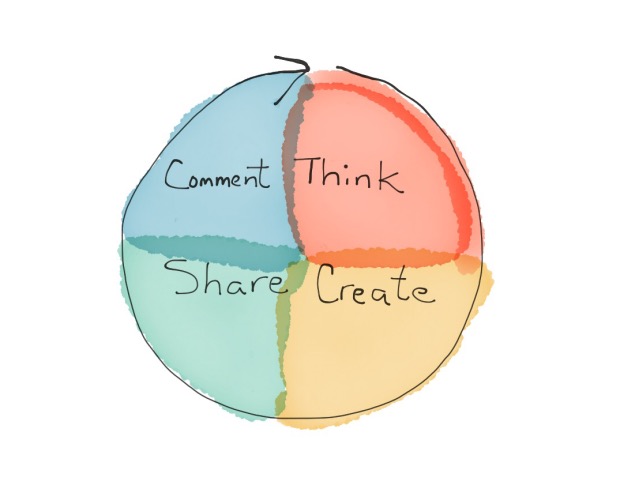Next Tech Talk on July 23rd, Focus: Collaboration!
Our addition to the NonProfit Capacity Building Program, “Tech Talk” networking has been a great success. We’re now approaching our fifth meeting–but it’s not too late to join in! If you’d like to be a part of it and haven’t yet signed up, reply to this post or Tweet us @ShiaNPCB or @awolber
The tech group will meet again on July 23rd at 10:30 a.m. at the DeVries Nature Conservancy (2635 N M 52, Owosso, MI 48867) where we’ll focus on Solving Problems Together.
Solve Problems Together by Andy Wolber (@awolber)
Collaborative tools hold much promise.
They let us work differently. A shared document simplifies collaboration. For example, consider how a shared agenda can change a meeting. Create the agenda, and share it with colleagues. One person inserts a comment. Another replies. I’ve seen a comment conversation resolve an issue days before a meeting occurs.
They let us work together. Collaborative apps let people work together. Multiple people can write words at the same time. Or tweak budget numbers. Or sort slides.
And they let us work almost anywhere. People can edit from any device, anytime, anywhere. Lots of apps offer collaborative capabilities (e.g., see the list at the end of this post.)
Yet a collaborative tool won’t improve the quality or quantity of your ideas. The tools help, but much hard work remains. We tend to forget the following steps when we’re dazzled by new tools.
1. Think
Before you engage with other people, think for yourself. Can you concisely express in words or an illustration the problem you seek to solve?
The question often frames the answer. “How do we reduce our expenses?” prompts different thinking than “How we we increase revenue?” even though both attempt to solve a budget imbalance. “How do we eliminate hunger?” points to different solutions than “How do we make sure every child in Shiawassee County receives enough healthy food?”
If you’re stuck, explore the provocations of creativity authors such as Roger Von Oech, Edward DeBono, or Michael Michalko.
2. Create
Consider the most effective way to express your idea. Funders expect us to use words and numbers: we “write a grant application” (words) with a “detailed budget” (numbers).
Sometimes, we also use images, sounds, or video. We turn numbers into pictures: we portray the problem, such as a graph that indicates an increase in poverty. Or a chart that conveys our organization’s impact, such as the percentage of people in the community we serve. We show pictures, such as “before” and “after” images of a site that volunteers cleaned up. We produce a video to convey the emotional impact our organization had on someone we helped.
3. Share
Tools help the most here: we can make our work visible to others with a quick tap (or click) of a “Share” or “Publish” button. Share to small groups of people to obtain comments. Share to the world when you want everyone to know.
Tools mean that meetings may occur differently. A meeting doesn’t have to be a sequence of extroverted individuals who talk. Even something as simple as a shared spreadsheet might allow anyone in the meeting to add an idea anytime without the need to interrupt or write on a flip chart.
We choose the terms by which others may use our publicly shared work. Choose a Creative Commons license to allow other people to reuse, modify, or adapt your work. Or not. It’s up to you. (As an organization, you might choose to license your work with specific terms. Watch a video to learn more.)
4. Comment
The heart of collaboration lives inside an effective comment. An English translation of a Buddhist document captures the essence of an effective comment: “It is spoken at the right time. It is spoken in truth. It is spoken affectionately. It is spoken beneficially. It is spoke with a mind of goodwill.”
Think back to the most recent workrelated meeting you attended. How does your speech measure up to each of the five characteristics above?
Collaborative tools let us share items easily. But the real, hard work of collaboration requires us to think, to create, and to comment to the best of our ability. We all have the opportunity to improve.
*A few collaborative apps…
Google Apps leads the collaborative office suite field. In tech terms: Google Docs, Sheets, and Slides all allow multiperson, simultaneous, realtime, crossplatform edits. Microsoft’s added some of these collaborative capabilities to Office 365, and will add more with the launch of Office 2016. Quip integrates mobile messaging with documents and spreadsheets.
Many tools offer multiperson and multidevice collaboration. These tools help you:
- manage lists (Todoist, Wunderlist),
- manage projects (Trello, Smartsheet),
- organize ideas (MindMeister, Mindomo, Padlet),
- construct diagrams (Lucidchart),
- design publications (Lucidpress),
- engage constituents (Salesforce, Insightly), or even
- make decisions together (Loomio).
Explore GrantCraft’s Harnessing Collaborative Technologies site (http://collaboration.grantcraft.org/) for more tools and ideas.


